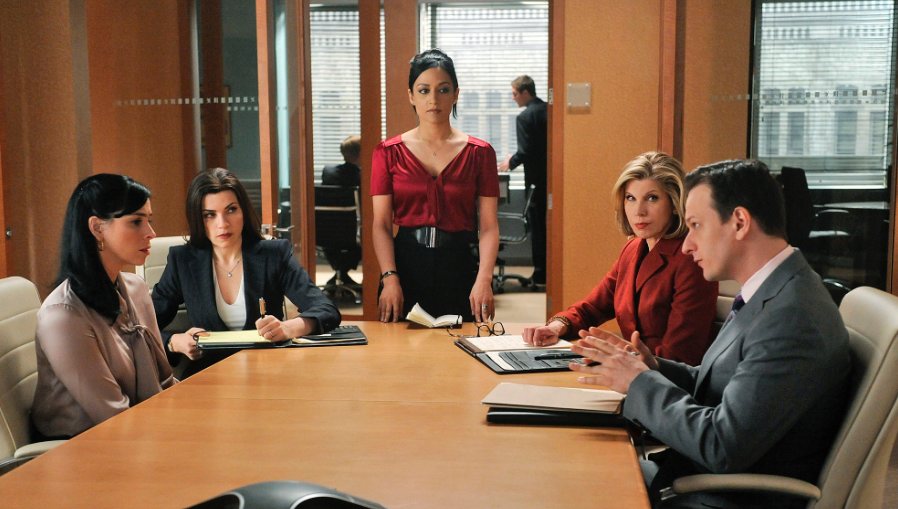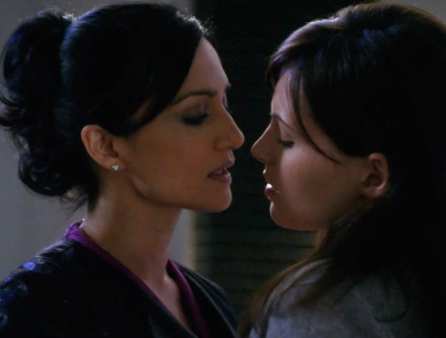
More than 40 episodes. That’s how long Kalinda Sharma and Alicia Florrick have now gone without appearing on-screen together on The Good Wife. And it’s a damn shame because their chemistry was the kind of thing that made us believe that yes, television had what it took to depict wonderful, nurturing friendships between women.
At this point, we see Kalinda — now in her final season of the critically-acclaimed drama — appearing more frequently than not alongside tertiary or guest characters. Her relationships — most notably that with her FBI paramour Lana Delaney — are not given enough screen time to develop into something believable. She’s barely given material that demonstrates her full emotional range; gone is the firecracker we grew to love in early seasons of the drama.
The cracks in the foundation are showing: We’re counting how many times Kalinda is “on speakerphone” when Alicia is obtaining information from her; or when another character serves as an inadvertent intermediary between the two. Again, it’s a damn shame.
With Kalinda’s exit comes the arrival of a big, huge elephant in the room: The Good Wife becomes yet another scripted drama with no people of color; part of what made it stand out was the seamless incorporation of a character like Kalinda, who upset the model minority myth that South Asians grapple with regularly. Yes, the hypersexualization of her character was problematic, but at the same time, she brought more good than bad to the drama — which could’ve otherwise ended up as bland and faceless as its CBS Sunday night counterpart Madam Secretary.
Knowing I’m not the only one feeling this distraught at how severely underutilized Kalinda’s been in The Good Wife‘s later seasons, I called upon fellow editor Anita Felicelli to convene a quick panel. The drama continues in the new year and what better time to assess the state of things, right? Right.
RG: So tell me what you think about The Good Wife? Why did you start watching it? When did you start watching it?
AF: I started watching in 2011, around the same time I stopped practicing law. Even though the show is about everything I geek out on (storytelling, law, politics, power, women), I wasn’t going to watch, actually, because I was tired of the reign of David E. Kelley lawyer shows. But then I heard about Archie Panjabi’s involvement, and remembered her from Bend It Like Beckham. So, I checked it out. I was hooked right away. Like lots of people, I think it’s the best show on television.
RG: I have to agree — for me, it’s neck-and-neck with Game of Thrones. Both shows are such artful depictions of how the personal and the political frequently clash.
Gut Reactions on Kalinda
RG: How did you feel initially watching Archie Panjabi put to the test the character of Kalinda Sharma?
AF: At first I thought that she was probably the most complex Indian American character on television. Panjabi has so much depth and charisma, she’s stolen a lot of scenes.
RG: How do you feel about the fact that Kalinda’s primary characterization is “mysterious” and “sexy”? Like, at first, I feel it’s very regressive.
AF: Yeah, that’s fair. For me, her primary characterization is that she’s extremely intelligent and resourceful. Other than that horrible misstep with her ex, it’s always clear there’s more going on with her than her use of sexual wiles, that she’s a complex, rounded character. But her allure for most viewers, I think, is that she’s mysterious-sexy.
I remember this interesting thing I read on LARB by Anne Helen Petersen:
“As an Indian woman in an enduringly (if quietly) racist society, a woman like Kalinda knew that she’d never be an Alicia or a Diane, so she uses a uniform that will deflect attention from her race and make her the best at her job. Everyone’s too busy looking at her skirt to realize that she’s swindling them — and making a lot of money doing it.”
Is that how you interpreted the decision to make Kalinda an investigator?
RG: That is sharp. I never thought about it on those terms, but it makes sense to Kalinda’s character. Her identity is to assume the identity of someone else. She hides in plain sight. It’s odd that Kalinda’s drive makes her, simultaneously, an example of the model minority myth.
AF: When I first read that, I was offended — of course Kalinda could be a lawyer! I’d assumed that the writers were going against a model minority stereotype, especially since early on she was one of the most competent and intelligent characters on the show. Two of our nation’s coolest attorneys — Vanita Gupta and Kamala Harris — have an Indian background so I thought it was a reach to think that the writers believed she couldn’t be a Diane.
RG: Maybe the question is in their mind — can the show’s co-creators Robert and Michelle King separate themselves from Kalinda’s ethnicity enough to believe that she could become a Diane? I think we are seeing the consequences of their imagination play out now.
AF: Yup, it’s only now that they’ve sidelined Kalinda that I kind of wonder if Peterson’s interpretation is more what the writers are going for. I think it’s always been clear that all the lawyers on the show use their identities to get results and to me Kalinda’s actions were no different from that. Not to mention, until the last two seasons, they couldn’t seem to win cases without her.

But when Alicia uses sex, it’s romantic — it’s trying to convince Finn to help her by dangling the possibility of a relationship. When Kalinda performs the same gesture with Lana, is there a different tenor? Maybe I gave the writers too much credit. I thought it was clever that a legal procedural was bringing in the importance of investigators to high-stakes litigation.
RG: I too wonder if I overestimated the Kings. I think we got a great comparison of Indians in the model minority myth early on. In season 1, there is an episode where Sarita Choudhury guest-starred as an Indian woman who immigrated illegally into the U.S. — and we learn when Kalinda is trying to interrogate a shopkeeper on Devon Street that she cannot speak Hindi. It was a moment when I was like, “Do more with this, The Good Wife writers! There is such a gold mine for her character here.”
AF: Yes, isn’t that pretty much always where writers’ rooms get stalled? Even after they create a wonderful character, it seems to be such a challenge for them to delve into back stories and realistic complications for their characters of color.
RG: That feeling is still fresh in me. That there are so many missed opportunities with Kalinda; we never meet her family. We are never allowed to really understand how she works — the way we get to even with tertiary characters like Elsbeth Tascioni.













I have been watching this terrific show since day one. I have to admit it was Chris Noth that originally got me to watch but I had an immediate crush on Alicia and Kalinda became the person I would want to share all the shades of grey with. She will be missed. Thanks for this great article.
I totally agree that not having Alicia and Kalinda in scenes together has begun to get in the way of telling the story organically. It is a real shame.
I will miss having Kalinda on my screen,and hope they give her character the send off she deserves. At least we can still see Archie in ‘The Fall’.
Great article